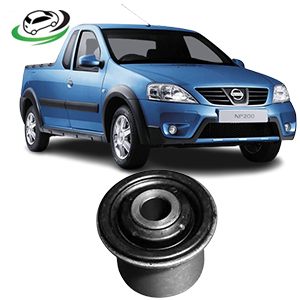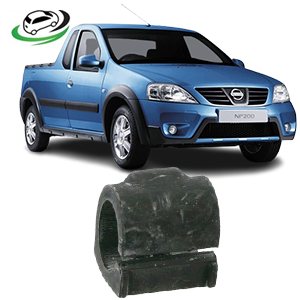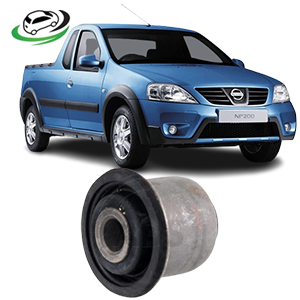-19%
Get Nissan Pick Up NP200 Front Lower Arm Bushing Assy GRM14827
The Front Lower Arm Bushing Assembly is a crucial component of a vehicle’s suspension system. It serves as the connection point between the front lower control arm and the vehicle’s chassis, allowing for controlled movement while absorbing shocks and vibrations from the road. This assembly is vital for maintaining vehicle stability, enhancing ride comfort, and ensuring effective handling. Understanding its structure, function, types, importance, maintenance, and potential signs of failure is essential for any vehicle owner.
Structure of the Front Lower Arm Bushing Assembly
The front lower arm bushing assembly consists of several key components that work together to provide flexibility and support:
- Outer Metal Shell: Typically made of steel or aluminum, this durable casing encases the bushing. It provides structural integrity, securing the bushing within the control arm and chassis.
- Inner Sleeve: This metal tube fits inside the bushing and allows the lower control arm to pivot while maintaining alignment and stability. The sleeve is crucial for the assembly’s overall functionality.
- Bushing Material: The core of the assembly is usually made from rubber or polyurethane. This material absorbs road shocks and vibrations, acting as a cushion that minimizes the transfer of these forces to the vehicle’s chassis.
- Bonded Design: In many assemblies, the rubber or polyurethane is bonded to both the inner sleeve and outer shell to prevent slippage and ensure a secure fit. This design helps maintain alignment and proper positioning of the control arm.
- Flexibility and Durability: The bushing is engineered to flex during suspension movement, allowing for controlled articulation while minimizing noise and harshness experienced by occupants.
Function of the Front Lower Arm Bushing Assembly
The front lower arm bushing assembly serves several essential functions within the suspension system:
- Vibration Damping: By absorbing road shocks and vibrations, the bushing prevents these forces from being transmitted directly to the vehicle’s chassis and occupants. This leads to a smoother ride, especially over rough terrain.
- Maintaining Wheel Alignment: The bushing secures the control arm in place, which is critical for maintaining the proper alignment of the front wheels. This ensures optimal handling, reduces tire wear, and enhances overall vehicle performance.
- Allowing Controlled Movement: The bushing enables the control arm to pivot as the suspension travels. This controlled articulation is vital for maintaining tire contact with the road, improving traction and stability.
- Noise Reduction: The bushing dampens noise generated by the movement of the control arm. Without it, metal-to-metal contact could produce clunking or rattling sounds during driving.
- Supporting Suspension Stability: The front lower arm bushing helps stabilize the suspension system, ensuring that the control arm functions properly during acceleration, braking, and cornering. This stability is essential for safe and predictable handling.
Types of Front Lower Arm Bushings
Different types of front lower arm bushings are used in various vehicles, each offering unique characteristics and benefits:
- Rubber Bushings: The most common type found in standard passenger vehicles. They provide excellent vibration damping and noise reduction, making them suitable for everyday driving. However, rubber can deteriorate over time due to exposure to heat, oil, and other environmental factors.
- Polyurethane Bushings: These are stiffer and more durable than rubber alternatives. They offer improved handling and responsiveness, making them popular in performance and off-road applications. However, they may transmit more noise and vibration to the cabin compared to rubber bushings.
- Hydraulic Bushings: These advanced bushings contain a fluid-filled chamber that enhances vibration absorption. They are often used in luxury or high-performance vehicles, providing a smoother ride and reducing noise effectively.
- Solid or Spherical Bushings: Solid bushings eliminate much of the flex associated with rubber or polyurethane, providing extremely precise handling. They are typically used in racing or high-performance applications, where control is prioritized over comfort.
- Adjustable Bushings: Some aftermarket and performance applications use adjustable bushings, which allow fine-tuning of the suspension geometry for specific driving conditions or preferences.
Importance of Front Lower Arm Bushings
The front lower arm bushing assembly is critical for several reasons:
- Enhanced Ride Comfort: By absorbing shocks and vibrations, the bushing contributes to a more comfortable driving experience. Passengers feel less impact from road imperfections, making long drives more enjoyable.
- Improved Handling and Stability: Properly functioning bushings maintain wheel alignment and stability, enhancing handling characteristics during cornering and sudden maneuvers. This is especially important in adverse weather conditions or when carrying heavy loads.
- Increased Suspension Longevity: The bushing reduces wear on other suspension components by absorbing impacts and controlling movement. This extends the lifespan of the entire suspension system, resulting in lower maintenance costs over time.
- Enhanced Safety: A well-functioning bushing ensures that the control arm operates correctly, contributing to vehicle stability and reducing the risk of accidents. Compromised bushings can lead to unpredictable handling, which can be dangerous.
- Noise Reduction: By cushioning the connection between the control arm and chassis, the bushing minimizes noise, creating a quieter cabin environment and enhancing the overall driving experience.
Maintenance of Front Lower Arm Bushings
Regular maintenance is essential to ensure the longevity and performance of the front lower arm bushing assembly:
- Routine Inspections: Regularly inspect the bushings for signs of wear, such as cracks, tears, or excessive movement. Rubber bushings, in particular, can degrade over time, especially in harsh environments.
- Listen for Noise: If you hear clunking or rattling sounds from the front suspension, it may indicate worn bushings. These noises often arise when the control arm moves excessively due to degraded bushings.
- Replace Worn Bushings: Front lower arm bushings should be replaced if they show signs of wear or damage. Depending on driving conditions, replacement may be necessary every 50,000 to 100,000 miles.
- Lubrication (if applicable): Some bushings, especially polyurethane types, may require periodic lubrication to reduce friction and prevent squeaking. Always use the manufacturer-recommended lubricant for best results.
- Check Alignment: Ensuring proper alignment of the suspension system is crucial. Misaligned bushings can lead to uneven tire wear and handling issues, which can compromise vehicle safety.
Symptoms of Failing Front Lower Arm Bushings
Several signs can indicate that the front lower arm bushing assembly is failing:
- Excessive Noise: Clunking, rattling, or knocking noises from the front suspension often signal worn or damaged bushings. These sounds occur when the control arm is no longer properly cushioned.
- Poor Handling: If the vehicle feels unstable, has increased body roll during turns, or exhibits poor steering response, it may be due to worn bushings affecting control arm performance.
- Increased Vibrations: Worn bushings may fail to absorb vibrations effectively, resulting in increased vibrations felt in the cabin, especially over rough roads.
- Uneven Tire Wear: Failing bushings can cause misalignment in the suspension, leading to uneven tire wear. This can compromise handling and reduce tire life significantly.
- Visual Inspection: A visual inspection may reveal cracked or damaged bushings. Any signs of deterioration should prompt immediate replacement to maintain safety and performance.
Conclusion
The Front Lower Arm Bushing Assembly is a critical component of a vehicle’s suspension system, significantly impacting ride comfort, handling, and safety. By absorbing shocks, maintaining alignment, and reducing noise, the bushing plays a vital role in the overall driving experience. Regular maintenance and timely replacement of worn bushings are essential to ensure optimal performance and prolong the life of the suspension system. Recognizing the symptoms of failing bushings, such as noise, vibrations, and handling issues, can help drivers maintain their vehicles effectively and avoid costly repairs. Understanding this assembly empowers vehicle owners to make informed decisions about maintenance and replacements, ensuring a safe and enjoyable driving experience.
Follow us on Facebook for more parts.



